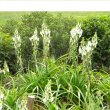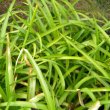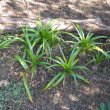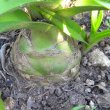| Botanical Name |
|
| Family |
Hyacinthaceae - The hyacinth family. |
| Pronunciation |
al-BEW-kah nel-SON-ee-eye |
| Common Name(s) |
IsiZulu: umaphipha; Umaphiphintelezi; Umababaza
|
| Plant Group |
- Bulb / Corm / Rhizome / Tuber / Epigeal bulb Bulbs: are made up of fleshy scales as in an onion
Corm: a short, swollen, underground stem that is hard and not fleshy as in a gladiolus
Tuber: a solid, fleshy, underground, storage organ as in a potato
Rhizome: an underground, horizontal, swollen stem at the base of the plant as in an iris
Epigeal bulb: bulbs that rest above the ground with only the roots anchoring the plant to the earth as in albuca
- Ground Cover A plant with a low-growing, spreading habit, grown specifically to cover the ground.
|
| Plant Size |
- Large
| Tree | 18m to 25m |
| Shrub | 3m to 4m |
| Perennial/ground cover | 75cm to 1m |
| Bulb | 80cm to 1.2m |
| Succulent | 1m to 1.5m |
|
| Position |
- Canopy Shade Canopy shade is found below closely grown trees where some light filters through. Ideal for the protection of herbaceous plants.
- Dry Shade Shady areas where soil has poor water retention or are dependent on rain for their moisture needs.
- Light or Dappled Shade Found below trees with sparse, open foliage. Ideal for the protection of herbaceous plants.
- Partial Shade The area is in shade for part of the day and in full sun for part of the day.
- Sun The area is in full sun for all or most of the day, all year round.
|
| General Information |
- Drought Tolerance: High The plant is well adapted to arid conditions; it can survive long periods of drought and high temperatures without extra water.
- Evergreen Plants that have leaves all year round.
- Frost: Half-hardy The plant is able to survive low temperatures and some frost but requires protection against severe frost.
- Sand tolerant Plants adapted to survive in nutrient poor, very sandy soils.
- Water Wise Plant species originating from low rainfall regions that require less water to survive and thrive than other plant species.
- Wind Tolerant Plants able to withstand the effect of strong winds.
|
| Specific Information |
Albuca nelsonii is a robust, evergreen, bulbous perennial with strap-shaped, slightly succulent leaves. It grows in clumps above the ground. I have found this plant invaluable for covering difficult areas where little else will grow. The leaves are attractive all year, they need very little water and grow equally well in full sun or full shade.
Albuca species belong more accurately to the succulent group of plants. Along with such bulbs as ledebouria and ornithigalum, they have epigeal bulbs, meaning that the large, fleshy bulb is partially exposed above the ground.
|
| Ad Break |
|
| Flowers |
| Description |
three green-striped 'petals' open out with the center three 'petals' remaining vertical.
|
| Season |
- Spring to Summer Plants will seldom bloom for the entire season as given in the list, but should flower during a period within these parameters.
|
| Colour |
|
| Growth Rate |
- Fast Specifying growth rate can be very misleading as there is considerable variation of growth rate depending on type and species of plant, available water, supplementary feeding, mulching and general care, as well as the plants suitability and adaptability to the garden environment.
|
| Plant Uses |
- Border A strip of ground, at the edge of a driveway or path in which ornamental plants or shrubs are planted.
- Container Trees, shrubs and ornamental species that can adapt to growing in a restricted environment.
- Ground Cover Low-lying plants that spread fast, require minimal maintenance, and cover large expanses or bare areas between bulbs or shrubs. They provide protection from erosion and drought and improve the visual appearance of the garden.
- Mass Planting Plants useful for filling a large area with just one or a few kinds of plants spaced close together. Creates a bold, dramatic effect and to reduces maintenance.
- Pioneer for new gardens A very fast growing plant, able to withstand hardship, that can be used to populate land that has recently been cleared of natural vegetation. These plants pave the way for slower-growing species by adding nutrients to the soil and creating leaf litter.
- Rock Garden An area constructed of larger rocks, arranged naturally, to emphasise the use of stones as a main element. Generally plants used do not need a lot of care.
- Suitable for coastal gardens Plants adapted to dry, sandy soil, forceful wind, limited rainfall and intense sunlight.
- Suitable for seaside gardens Plants that will survive the hostile environment of harsh salty winds, dry sandy soil, irregular rainfall and heat found in seaside gardens.
- Wild Garden An indigenous garden planted for the benefit of wildlife and birds. Provides food, water, a variety of mini-biomes and no poisonous chemicals are used.
|
| Distribution and Habitat |
in KwaZulu-Natal and the Eastern Cape, in lightly shaded areas in grassland and on coastal cliffs
|
| Planting Suggestions |
Plant in well-drained soil to which compost has been added. Be sure to leave the top half of the bulb exposed above the ground. Watch out for mole rats as they are most partial to this bulb.
|
| Medicinal Uses |
A mixture made from bulbs of Albuca and tubers of Kniphofia is taken as protection against sorcery.
|
| Ad Break |
|










Comments
albuca
My friend has divided and given me some albucas. As it's almost winter should I store these bulbs for spring or can they still be planted?
Time of year for planting Albuca bulbs
Hi Saskia
You can plant them immediately. As these are not real bulbs, but epigeal bulbs, remember to plant them somewhat above the ground.
Kind regards
Lorraine
albuca plant
Is the albuca frost hardy?
Answer already supplied
Refer to 'General information' above.
I adore these. Possibly the
I adore these. Possibly the easiest plants that require no maintenance and grow in any condition (even under pine trees). I inherited mine from my mom when she divided hers up. Not a plant often seen in nurseries which is a pity. Spectacular mass planted.
Versatile albuca
Hi Gerlinde
Sincere apologies for not replying to your comment sooner.
I have also found them to be so versatile and it is a great pity that they are not made more available. They tolerate hot, infertile soil as well as they do shade and good garden loam. Unfortunately they are also much loved by the mole-rats in my area. They eat the entire bulb, leaving nothing to allow them to recover. I used to have dozens of them but am now left with only a plant here and there. I plan to pot my last surviving plants just so I can enjoy the lovely green foliage.
Kind regards
Lorraine
Discuss this plant
Share knowledge, ask a question or give an experience.